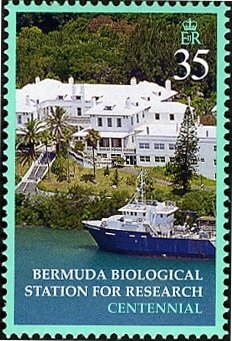Stamp: Biological station and ship (Bermuda 2003)
Biological station and ship (Bermuda 2003)
04 February (Bermuda ) within release Bermuda Biological Station for Research, Cent. goes into circulation Stamp Biological station and ship face value 35 Bermudian cent
| Stamp Biological station and ship in catalogues | |
|---|---|
| Stamp Number: | Sn:BM 857 |
Stamp is square format.
Also in the issue Bermuda Biological Station for Research, Cent.:
- Stamp - Biological station and ship face value 35;
- Stamp - Spotfin Butterflyfish (Chaetodon ocellatus) face value 70;
- Stamp - Researcher probing reef face value 85;
- Stamp - Shrimp face value 1;
|
Data entry completed
50%
|
|
|---|---|
| Stamp Biological station and ship in digits | |
| Country: | Bermuda |
| Date: | 2003-02-04 |
| Print: | Offset and Lithography |
| Perforation: | 14 |
| Format: | Stamp |
| Face Value: | 35 Bermudian cent |
Stamp Biological station and ship it reflects the thematic directions:
A landscape is the visible features of an area of land, its landforms and how they integrate with natural or man-made features. A landscape includes the physical elements of geophysically defined landforms such as (ice-capped) mountains, hills, water bodies such as rivers, lakes, ponds and the sea, living elements of land cover including indigenous vegetation, human elements including different forms of land use, buildings and structures, and transitory elements such as lighting and weather conditions. Combining both their physical origins and the cultural overlay of human presence, often created over millennia, landscapes reflect a living synthesis of people and place that is vital to local and national identity. The character of a landscape helps define the self-image of the people who inhabit it and a sense of place that differentiates one region from other regions. It is the dynamic backdrop to people’s lives. Landscape can be as varied as farmland, a landscape park, or wilderness. The earth has a vast range of landscapes, including the icy landscapes of polar regions, mountainous landscapes, vast arid desert landscapes, islands and coastal landscapes, densely forested or wooded landscapes including past boreal forests and tropical rainforests, and agricultural landscapes of temperate and tropical regions.
A ship is a large watercraft that travels the world's oceans and other sufficiently deep waterways, carrying passengers or goods, or in support of specialized missions, such as defense, research and fishing. Historically, a "ship" was a sailing vessel with at least three square-rigged masts and a full bowsprit. Ships are generally distinguished from boats, based on size, shape and load capacity.
Science is a systematic discipline that builds and organises knowledge in the form of testable hypotheses and predictions about the universe.Modern science is typically divided into two or three major branches: the natural sciences (e.g., physics, chemistry, and biology), which study the physical world; and the behavioural sciences (e.g., economics, psychology, and sociology), which study individuals and societies.The formal sciences (e.g., logic, mathematics, and theoretical computer science), which study formal systems governed by axioms and rules, are sometimes described as being sciences as well; however, they are often regarded as a separate field because they rely on deductive reasoning instead of the scientific method or empirical evidence as their main methodology. Applied sciences are disciplines that use scientific knowledge for practical purposes, such as engineering and medicine
Coastal areas are local administrative units (LAUs) that are bordering or close to a coastline. A coastline is defined as the line where land and water surfaces meet (border each other).




